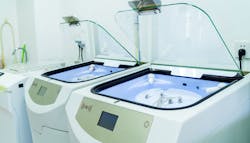As much of the Sterile Processing & Distribution profession buzz swirls around the emergence of disposable/single-use-only endoscopic devices, SPD leaders want to ensure those on the front lines remain grounded in the fundamentals.
They quickly point out that the media coverage surrounding healthcare-associated infections likely stemming from improper reprocessing may not be blamed totally on the devices and technological complexity, even as they acknowledge that endoscopes include numerous nooks, crannies and areas that can be hard to clean, which makes them hard to disinfect and sterilize.
But the disposable/single-use-only endoscopes don’t represent the silver bullet that some might hope will solve the quality issues bedeviling SPD operations. In short, this represents less of a device issue and more of a communication, education and training issue that must be checked and solved regardless of the device or technology being upgraded or redesigned. It’s akin to the old adage, if a device isn’t clean, it can’t be sterilized.
For the fourth consecutive year, Healthcare Purchasing News surveyed a small group of sterile processing subject matter experts on seven potential – but likely scenarios – that may direct and redirect how SPD navigates the 2020s from a quality standpoint. HPN asked the executives from device manufacturers and reprocessing product companies to rank the seven strategies (1 being the most important or influential; 7 being the least important or influential).
To show the trends year over year, HPN publishes the aggregate respondent data from 2020, 2019 and 2018 as well. What’s noteworthy is that the results seem consistent. In fact, the top two strategies this year are the same as the top two last year, which had represented a transposition of the top two the year before that. Essentially, the top two strategies – fundamental in their own right – have remained consistent for three consecutive years. Curiously, the proverbial Bullwhip moves up a notch to No. 3 and Big Brother jumps three spots to No. 4 – both of them above the relatively new disposable/single-use tech breakouts.
1. Thoroughly educating, training, vetting and certifying SPD staffers on proper and effective cleaning techniques
2021 average score: 1.7
2020 average score: 2.43
2019 average score: 2.5
2018 average score: 1.5
2. Demanding, receiving and following validated instructions for use (IFUs)
2021 average score: 2.6
2020 average score: 2.64
2019 average score: 1.9
2018 average score: 2.5
3. Holding staffers accountable/responsible for endoscope cleaning “violations”
2021 average score: 4.0
2020 average score: 4.23
2019 average score: 4.8
2018 average score: 2.8
4. Comprehensively monitoring and tracking all steps in the process with sensors and video technology
2021 average score: 4.5
2020 average score: 4.85
2019 average score: 4.7
2018 average score: 3.4
5. Switching to endoscopes that contain disposable/single-use-only components that can be discarded or swapped out after use
2021 average score: 4.8
2020 average score: 3.62
2019 average score: 4.1
2018 average score: n/a
6. Switching to disposable/single-use-only endoscopic devices for selected endoscopic procedures only (e.g., bronchoscopy, etc.)
2021 average score: 5.3
2020 average score: 4.46
2019 average score: 4.3
2018 average score: n/a
7. Switching to disposable/single-use-only endoscopic devices for all endoscopic procedures
2021 average score: 6.6
2020 average score: 4.77
2019 average score: 6.1
2018 average score: 4.8
HPN invited respondents to explain their perspectives and even offer alternatives. Here’s what they shared.
Shaun Sweeney, Vice President, Cygnus Medical, emphasizes that “thoroughly educating, training, vetting and certifying endoscopy staffers on proper and effective cleaning techniques” is essential. “Bedside cleaning still falls within the realm of the endoscopy unit and is the most important step in the process,” he added.
Although she ranked No. 6 a little higher, Melinda “Mindy” Benedict, CIC, CFER, Global Senior Manager, Infection Prevention, Olympus Corporation of the Americas, qualifies the option from a regulatory perspective. “Single use for certain patients and procedures is recommended by the FDA, whose guidance is of utmost importance,” she said.
Gregg Agoston, Vice President, Business Development, SPD Transformation Services, SpecialtyCare, remains squarely in the camp of the top 4 rankings (with the bottom two in that group transposed). He points to staff quality as paramount.
“For the processing of flexible endoscopes used in a GI clinic, most hospitals and clinics have dedicated staff whose only job is to assist with the endoscopes and process them,” Agoston noted. “Having a dedicated team, who are highly trained to follow all steps outlined in the [instructions for use] is critical to the successful cleaning and processing of the devices. For flexible endoscopes used in the OR, many hospitals process these in SPD often with much lower rates of confidence that all processes in the IFU have been followed. This is partially due to the competency of the technician who performed the cleaning. It is also due to the common practice in most SPDs where everyone takes a turn at all functions (including decontamination, assembly, sterilization, case carts etc.).
“By not designating qualified staff to the important function of cleaning flexible endoscopes, significant variation is created in quality,” Agoston continued. “With some flexible endoscopes IFUs containing over 100 pages of instruction for processing, if the hospital does not designate highly trained specialists to clean flexible endoscopes there is a significant chance that the instruments will not be properly prepared for sterilization or high-level disinfection.”
Agoston points to cross-training and multitasking as the culprit even though some feel it’s more efficient.
“When we look at the root cause of processing failure, it usually boils down to not having qualified staff perform the processes, lack of proper equipment/supplies for the process and the lack of standard work developed as the process,” he indicated. “Allowing everyone to take a turn in decontamination to clean complex instruments results in significant errors.”
Switching fully to disposable/single-use devices poses its own challenges, according to Agoston.
With over 50 million GI procedures and another 25 million surgical procedures performed with flexible endoscopes (e.g., ureteroscopy, cystoscopy, ENT, etc.), if we switched to disposable flexible endoscopes, the mountains of surgical waste would be enormous,” he said. “In addition, while flexible endoscopes are complex instruments, they certainly are not the only complex instrument that we ask SPD to process. If we are calling for disposable or ‘semi-reusable’ flexible endoscopes because we are not confident in SPD to process them, then we should be calling for disposables for Da Vinci instruments, and most of the other complex instruments used in minimally invasive orthopedic, spine, ENT, etc.”
Agoston traces the roots to quality concerns in SPD to roughly 80 years ago.
“The cause of all of this is found in the origin of SPD back in the 1940s when the American College of Surgeons called for a centralization of the sterilization process,” he recalled. “At the time the instruments were very simple by today’s standards, but the sterilization process was complex due to not having automation for the sterilization process or record keeping of the sterilization parameters. At the time, you could move staff over from dietary or [environmental services] and with good supervision, [they could] clean and sterilize the stainless steel instruments used in open surgical procedures that were being done at that time.
“Fast forward to the advent of [minimally invasive surgery] and advanced surgical procedures where the majority of the devices are complex,” he continued. “Thinking that you can bring in ‘lay-people’ and expect them to know every IFU, work process, piece of equipment in the department, how to disassemble, clean, reassemble, test, package and sterilize for every instrument in a hospital is not attainable, particularly given the very high rate of turnover in SPD staff.
“The solution is in allowing for specialization in SPD where there [are] staff who are more highly trained to process complex instruments,” he recommended. “We do this in orthopedics with the help of the vendor reps, and we do it in GI endoscopy clinics. For the vast amount of other complex instruments for MIS, everyone in SPD takes a turn. Recall that there are many small diameter flexible endoscopes that are processed by SPD. This variation in staff competency results in significant variation in quality.”
Automation plays a key role, too, according to Agoston.
“Automation of processes is very important because no matter what is done, humans will vary in their processes,” he noted. “Machines do not unless they are malfunctioning. With machines we get consistent times, chemical exposure, rinsing and disinfection. Most rigid endoscopes can be processed through automated washers if they have the proper container, but most hospitals do not do this, resulting in variation in cleanliness. All facilities processing flexible endoscopes should have the latest equipment for cleaning and processing the devices. This can also be said for DaVinci instruments where we see hospitals that do not have the appropriate ultrasonic equipment to clean the devices. The list goes on.
Supervision also must be addressed. “Without a knowledgeable supervisor and documented competency, process variation again will enter,” he said. “Variation is the enemy of quality.”





